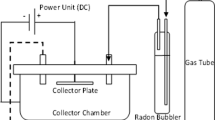Abstract
Against the improvement of science and technology, earthquake is one of natural disasters that human cannot predict. Researchers indicated that there are many earthquake precursors. One of these precursors is a change in radon concentration in thermal waters about of active faults. Most of radon monitors cannot detect radon concentration in water directly, and they can detect radon concentration in air. Therefore, radon molecules should be separated from water and transferred to air. In this study, a bubbling system was used for the transfer of radon from water to air. Mathematical and neural network modeling of this system has been performed. The time constant parameter as an indicator of the separation rate was less than 20 min in most of experimental conditions. After validation of the models with experimental data, the effects of water and air flow rates and water temperature on the speed response of this system have been studied.
Similar content being viewed by others
References
https://doi.org/rcep.ut.ac.ir/FA/precursor/pdefimition.asp. Accessed May 19, 2016.
Erees, F.S., Radon concentrations in thermal waters related to seismic events along faults in the Denizli Basin, Western Turkey, J. Radiat. Meas., 2007, vol. 42, pp. 80–86.
Surbeck, H., A radon-in-water monitor based on fast gas transfer membranes, Proc. Int. Conf. on Technologically Enhanced Natural Radioactivity (TENR) Caused by Non-Uranium Mining, Szczyrk, Poland, 1996, pp. 16–19.
Jimenez, F., Nunez, M., and Kafarov, V., Study and modeling of simultaneous hydrodesulfurization, hydrodenitrogenation and hydrodearodearomatization on vacuum gas oil hydrotreatment, Proc. European Symposium on Computer Aided Process Engineering, 2005, p.15.
Deckwer, W.D., Modeling for Bubble Column Reactors, New York: Wiley, 1992.
Behin, J., Soltanian, G., Jafari Nasr, M., and Falahi Yekta, M., Modeling and simulation of multi stages bubble column in produce of hydrogen peroxide process, Proc. 10th Conference of Chemical Engineering, Zahedan, Iran, 2004, p.1.
Nikezic, D. and Uroševic, V., A theoretical study of radon measurement with activated charcoal, Nucl. Instrum. Methods Phys. Res., Sect. A, 1998, vol. 406, pp. 486–498. https://doi.org/10.1016/S0168-9002(98)00176-4
Shimizu, K., Takada, S., Minekawa, K., and Kawase, Y., Phenomenological model for bubble column reactors: Prediction of gas hold-ups and volumetric mass transfer coefficients, Chem. Eng. J., 2000, vol. 78, p.21.
Patankar, S.V., Numerical Heat Transfer and Fluid Flow, Series in Computational Methods in Mechanics and Thermal Sciences, New York: Hemisphere, 1980.
Author information
Authors and Affiliations
Corresponding author
Additional information
The article is published in the original.
Rights and permissions
About this article
Cite this article
Mirzaie, M. Neural Network Modeling and Experimental Study of Radon Separation from Water. Theor Found Chem Eng 52, 429–437 (2018). https://doi.org/10.1134/S0040579518030120
Received:
Published:
Issue Date:
DOI: https://doi.org/10.1134/S0040579518030120




